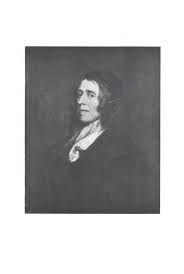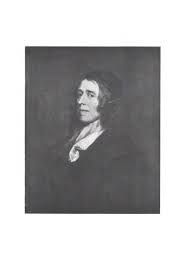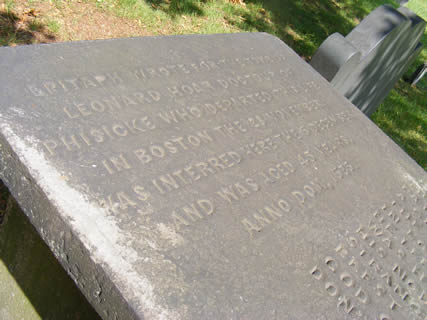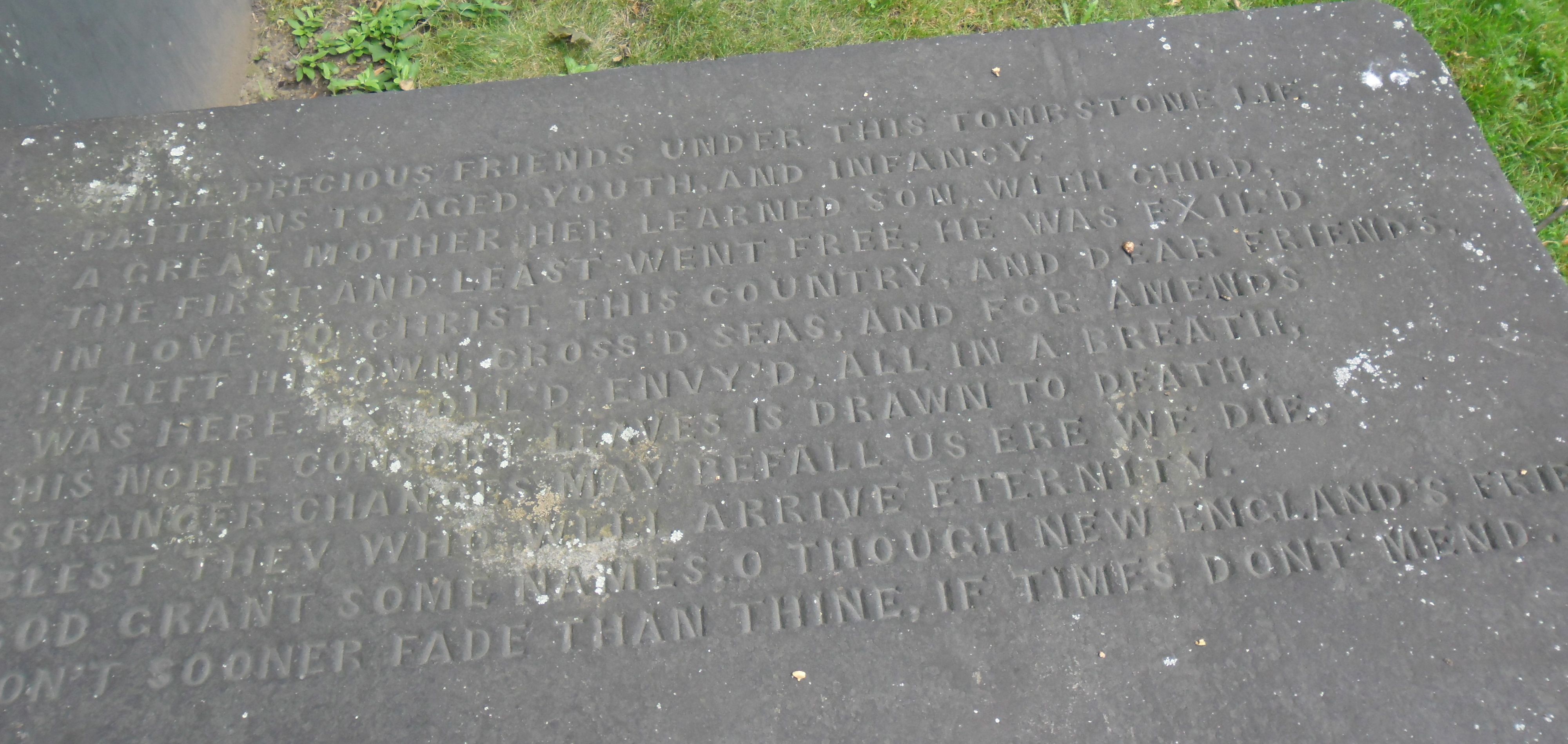He came to this country about 1639 with his mother and four siblings and settled in that part of Braintree which is now known as Quincy. He went back to England in 1653 and settled, as a clergyman, in Wenstead, Essex County. He held Ecclesiastical posts in England and earned a biblical scholarship. He returned, with his wife, to Boston in Jul 1672 and preached for a short time at the South Church. He was soon called to be the third president of Harvard College in Dec 1672 and served for three years.
He was an early American clergyman and educator. He was educated at Harvard College, graduating in 1650, and later studied medicine at Cambridge University. He occupied various ecclesiastical positions in England and produced works on biblical scholarship. After Charles Chauncy died, he was immediately elected and installed as the president of Harvard on 10 Dec 1672; which position he held until he resigned on 15 Mar 1675. He died nine months after his resignation. He had the distinction of being the first president of Harvard College who was also a graduate of it.
His epitaph in the Hancock Cemetery at Quincy, Norfolk County, MA reads:
Leonard Hoar - died Nov.28,1675 in Boston a.45, and interred here Dec.6, new gs.
He was not well liked by his students or apparently even the people of Massachusetts in part due to his radical religious views. In Daniel Munro Wilson, Where American Independence Began (1902), pp. 53–54, the author writes:
"At all events the students fell away from the president, and 'set themselves to Travestie whatever he did and said, and aggravate everything in his behavior disagreeable to them, with a design to make him Odious'."
Per Harvard University Web Site
Term of office: 1672-1675
By the time Leonard Hoar (ca. 1630-1675) became president in 1672, Harvard had lasted long enough to produce homegrown leadership. Not until the 1971 arrival of Derek Bok, who holds a Harvard law degree, would there be a Harvard chief executive who, like the first two presidents, had not been educated at the College.
Hoar took office with every hope of transforming Harvard into a major research institution, complete with chemical laboratories, a botanical garden and an agricultural-research station, and a mechanical workshop - all outlined in a letter of December 1672 to Robert Boyle, the eminent British chemist and physicist. But so grand an enterprise was not to flower in full until the 19th century.
The detailed reasons for Hoar's brief presidency have remained obscure: historian Samuel Eliot Morison notes that while everyone on the local scene talked about Hoar, little definitive evidence got committed to paper. It seems clear, however, that both his personality and actions proved unacceptable to too many. Students mocked his words and deeds, and tutors resigned in disgust. At one point, Hoar's heavy-handed discipline resulted in the flogging of a student by a jailer who was later removed for cruelty.
Twice (in October 1673 and October 1674), Hoar's case came before the Great and General Court, with the threat of dismissal hanging in the balance. By the winter of 1674-75, conditions had degenerated to the point that the entire student body walked out. In March 1675, Hoar resigned. Utterly broken in spirit, he died shortly afterwards. More than three centuries later in 1976, at the request of a portrait painter touched by Hoar's plight, the Massachusetts Senate approved a resolution clearing Hoar of misconduct.
Hoar left behind one quiet but greatly influential innovation: a series of triennial (three-year) catalogs of Harvard graduates listed by their respective Classes. When the first installment of 200 graduates appeared in 1674, it was probably the first list of college or university alumni published anywhere, according to Morison. After 1875, the compendium appeared at five-year intervals. The last "Quinquennial Catalogue" (which also includes all Harvard officers to date) appeared in 1930 and remains a prime reference on the 65,584 individuals who had thus far received Harvard degrees.
He came to this country about 1639 with his mother and four siblings and settled in that part of Braintree which is now known as Quincy. He went back to England in 1653 and settled, as a clergyman, in Wenstead, Essex County. He held Ecclesiastical posts in England and earned a biblical scholarship. He returned, with his wife, to Boston in Jul 1672 and preached for a short time at the South Church. He was soon called to be the third president of Harvard College in Dec 1672 and served for three years.
He was an early American clergyman and educator. He was educated at Harvard College, graduating in 1650, and later studied medicine at Cambridge University. He occupied various ecclesiastical positions in England and produced works on biblical scholarship. After Charles Chauncy died, he was immediately elected and installed as the president of Harvard on 10 Dec 1672; which position he held until he resigned on 15 Mar 1675. He died nine months after his resignation. He had the distinction of being the first president of Harvard College who was also a graduate of it.
His epitaph in the Hancock Cemetery at Quincy, Norfolk County, MA reads:
Leonard Hoar - died Nov.28,1675 in Boston a.45, and interred here Dec.6, new gs.
He was not well liked by his students or apparently even the people of Massachusetts in part due to his radical religious views. In Daniel Munro Wilson, Where American Independence Began (1902), pp. 53–54, the author writes:
"At all events the students fell away from the president, and 'set themselves to Travestie whatever he did and said, and aggravate everything in his behavior disagreeable to them, with a design to make him Odious'."
Per Harvard University Web Site
Term of office: 1672-1675
By the time Leonard Hoar (ca. 1630-1675) became president in 1672, Harvard had lasted long enough to produce homegrown leadership. Not until the 1971 arrival of Derek Bok, who holds a Harvard law degree, would there be a Harvard chief executive who, like the first two presidents, had not been educated at the College.
Hoar took office with every hope of transforming Harvard into a major research institution, complete with chemical laboratories, a botanical garden and an agricultural-research station, and a mechanical workshop - all outlined in a letter of December 1672 to Robert Boyle, the eminent British chemist and physicist. But so grand an enterprise was not to flower in full until the 19th century.
The detailed reasons for Hoar's brief presidency have remained obscure: historian Samuel Eliot Morison notes that while everyone on the local scene talked about Hoar, little definitive evidence got committed to paper. It seems clear, however, that both his personality and actions proved unacceptable to too many. Students mocked his words and deeds, and tutors resigned in disgust. At one point, Hoar's heavy-handed discipline resulted in the flogging of a student by a jailer who was later removed for cruelty.
Twice (in October 1673 and October 1674), Hoar's case came before the Great and General Court, with the threat of dismissal hanging in the balance. By the winter of 1674-75, conditions had degenerated to the point that the entire student body walked out. In March 1675, Hoar resigned. Utterly broken in spirit, he died shortly afterwards. More than three centuries later in 1976, at the request of a portrait painter touched by Hoar's plight, the Massachusetts Senate approved a resolution clearing Hoar of misconduct.
Hoar left behind one quiet but greatly influential innovation: a series of triennial (three-year) catalogs of Harvard graduates listed by their respective Classes. When the first installment of 200 graduates appeared in 1674, it was probably the first list of college or university alumni published anywhere, according to Morison. After 1875, the compendium appeared at five-year intervals. The last "Quinquennial Catalogue" (which also includes all Harvard officers to date) appeared in 1930 and remains a prime reference on the 65,584 individuals who had thus far received Harvard degrees.
Inscription
Epitaph wrote for the Tomb of
Leaonard Hoar Doctour of
Phisick who departed this life
In Boston the 28 November,
Was interred here on the 6 December
And was aged 45 yearts,
Anno Dom, 1676
Three precious friends under this tombstone lie
Patterns to aged, youth, and infancy,
A great teacher, her learned son, with child,
The first and least went free, he was exil'd
In love to Christ, this Country, and dear friends,
He left his own, cross'd seas, and for amends
Was here extoll'd, envy'd all in a breath
His noble consort leaves is drawn to death.
Stranger changes may befall us ere we die
Blest they who well arrive eternity.
God grant some names, o though N. Englands friend.
Don't sooner fade than thine, if times don't mend.
Family Members
Advertisement
Advertisement









